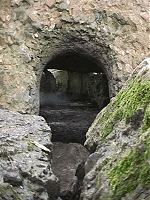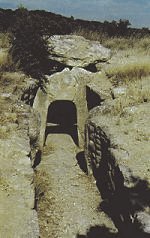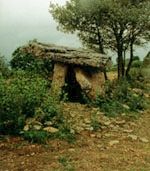EAST
OF
BRITTANY:
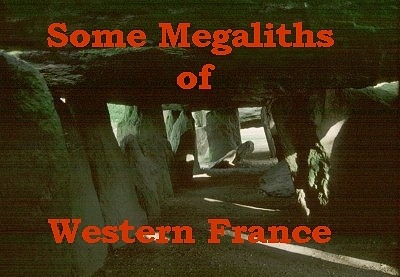
part
II
text
and photographs by
Anthony
Weir
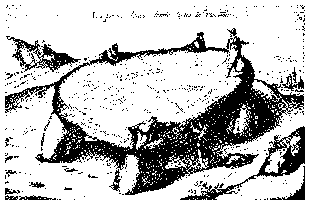
A sixteenth-century sketch
of the Pierre Levée, Poitiers
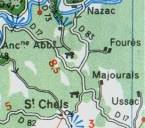
The tombs shown on this site are mostly either the squat Dolmens
simples which resemble the æsthetically more-impressive
Irish Portal Tombs, or long gallery-tombs of the type
known in France as Allées-couvertes (covered passages).
The well-known sepulchres of Brittany are mainly Passage-tombs,
which are rare elsewhere in France - and relatively rare throughout
Europe. In Gallery-tombs the gallery is the tomb, so to speak,
whereas in Passage-tombs the passage leads to the tomb proper,
which is a larger space or chamber. All megalithic tombs in
France tend to be called dolmens (from the Breton for
'stone table'), and Passage-tombs are often - confusingly -
called Dolmens à galerie. But they can, more accurately,
be termed Dolmens à chambre et couloir.
Quite
a few French tombs, especially Dolmens simples, still
have their covering and surrounding mound (tumulus or cairn).
Some
of the Allées-couvertes are huge. The Grand Dolmen
of Bagneux East (now a suburb of Saumur) is the largest megalithic
chamber in Europe. Dances and banquets have been held within
it - and it has for over a century been part of a café-bar.
Tombs like this never had a covering mound or cairn, but were
a kind of Temple-tomb rather more primitive than those found
in Malta.
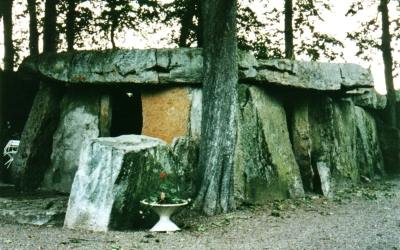 click
for more
click
for more

 Bagneux East, Saumur (Maine-et-Loire)
Bagneux East, Saumur (Maine-et-Loire) 
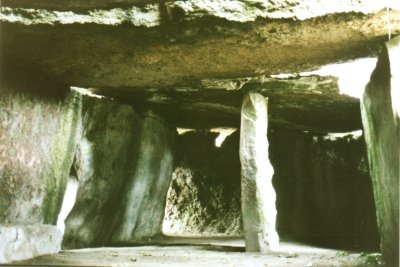
Others
- especially Dolmens simples of the limestone
plateaux known as causses - are as small as
a Megalithic Cist (Coffre in French) or the smallest
Irish Wedge-tomb.
The
Dolmen de la Madeleine, one of several Allées-couvertes
near Gennes was adapted to become a bakehouse (long since disused),
and others have, naturally, become storehouses and sheds.
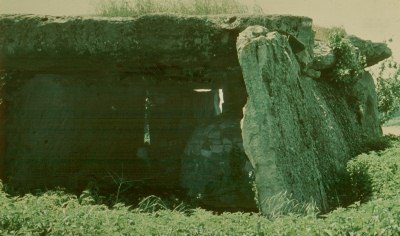
Gennes (Maine-et-Loire): bread-oven
inside a large tomb 
known as the Dolmen de la Madeleine;
 and
the same tomb from the front, narrower, lower end.
and
the same tomb from the front, narrower, lower end.
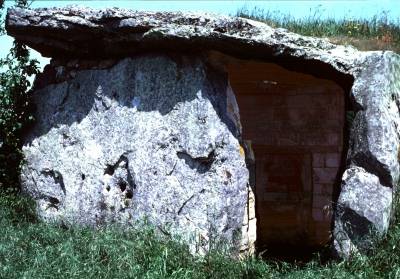
click the picture for a high-resolution image
French dolmens rejoice
in a variety of names. Whereas Irish tombs tend to be Giants'
Graves or (after a couple of fleeing legendary lovers like
Tristan and Isolde) Dermot and Grania's Bed, French tombs
are mostly more prosaically described as Pierre-Levée
(raised stone), Pierre Folle (crazy stone), Pierre
Couverte (covered stone), Pierre-Pèse (heavy stone),
or Pierres-Plates (flat stones) - though some, especially
in the West, are associated with spirits or genii loci:
La Grotte or La Roche aux Fées (Fairy Rocks or
Grotto).
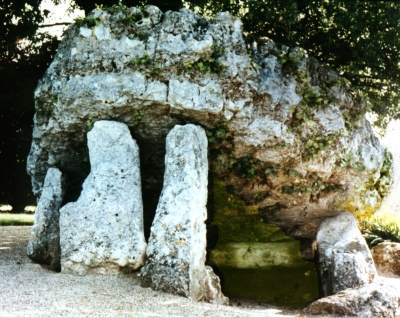
click
to see old postcards
La Pierre Levée,
in a south-eastern suburb of Poitiers (Vienne)
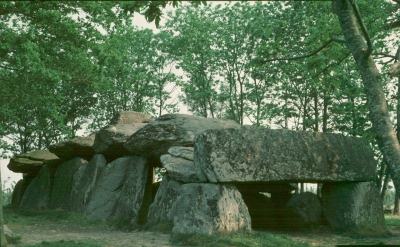
 La Roche aux Fées, Essé (Ille-et-Vilaine),
La Roche aux Fées, Essé (Ille-et-Vilaine),
with interior headroom of two metres and
big enough to be used for Kermesses 
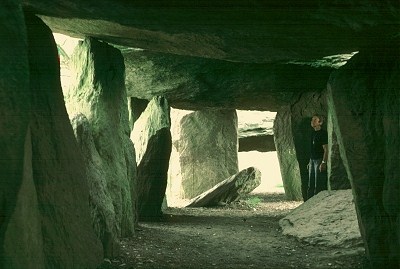
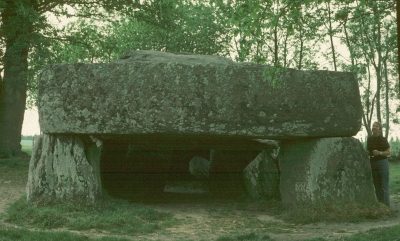
In a more literary vein, one that I have not yet visited in
the commune of Fargues
at Lumé in the département of the Lot-et-Garonne
is known as 'Gargantua's Bed'. (But the name of Gargantua has
been attached to menhirs and natural features all over France
and beyond.)
More prosaically, a fine and large Gallery-tomb in Brittany
is known as 'The Merchants' Table' because it made a handy stall
for itinerant pedlars.
One was known as Le Caveau du Diable
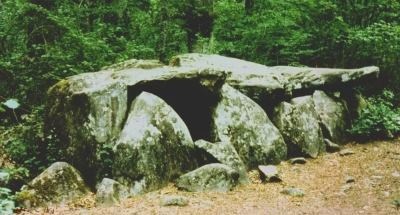
Dolmen de la Contrie,
Ernée (Mayenne)
(The
Devil's Cave) as well as Dolmen de la Contrie.
Others
have been Christianised - most dramatically the Dolmen de
la Madeleine on an island in the river Vienne, whose (preumably
three or four) supporting uprights were replaced in the 12th
century by four elegant Romanesque columns, to make it into
a little shrine.
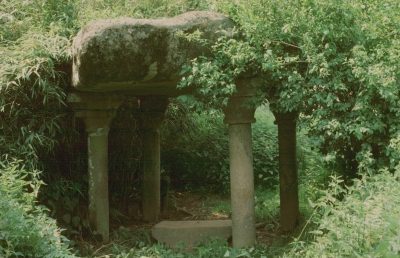
Dolmen de
la Madeleine, south of Confolens
(Charente)
A menhir on the borders of Brittany and South Normandy was Christianised
with a niche for a statuette now gone.
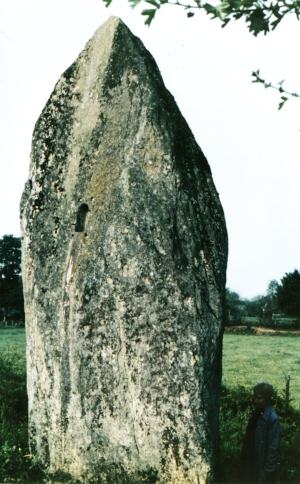
Menhir de Pierre Frite
(Mayenne)
while
one of the most beautiful menhirs in the world now stands
at the corner of the façade of Le Mans Cathedral.
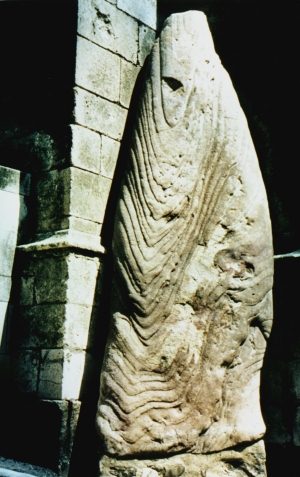
click
for a larger photo
Monolith at Le Mans (Sarthe)
Some menhirs attract legends like antennæ - especially
one as remarkable as La Pierre Percée leaning 4 metres
high at Drache in Touraine, with its natural hole through which
troth was plighted by the exchange of bouquets. Children whose
heads were passed through the hole were protected from scrofula
(TB). Even the grass at its foot protected against evil spells
and spirits.
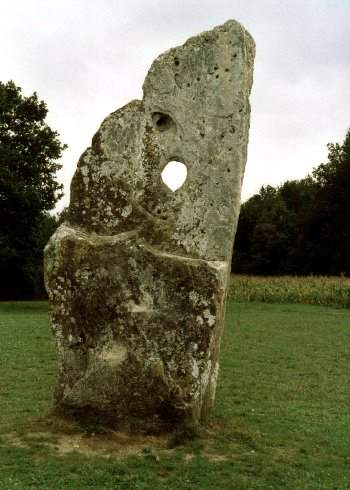
click
for another view
Drache (Indre-et-Loire): 4 metres high.
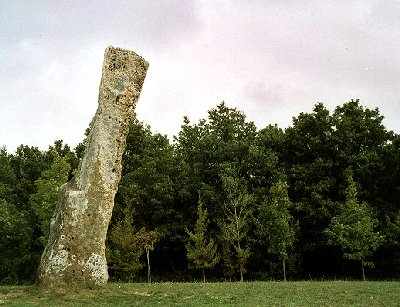
click
for another view
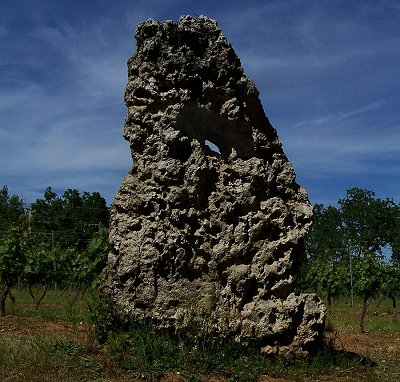
a
splendid standing-stone in the Lot
This selection of photographs
has been made mainly from æsthetic considerations, for
I think that the value of megaliths lies in their sculptural
beauty and ambiance rather than their antiquity: after all,
none is older - or more beautiful - than the stone of which
it is composed.
click
to 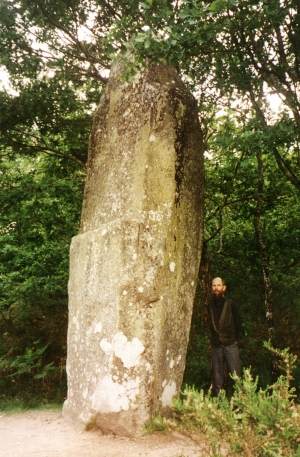 enlarge
enlarge
The author and Menhir at Cinturat
(Haute-Vienne)
This
selection of photographs has been made mainly from æsthetic
considerations, for I think that the value of megaliths lies
in their sculptural beauty and ambiance rather than their antiquity:
after all, none is older - or more beautiful - than the stone
of which it is composed.


Kermario
Alignments, Carnac, Brittany


